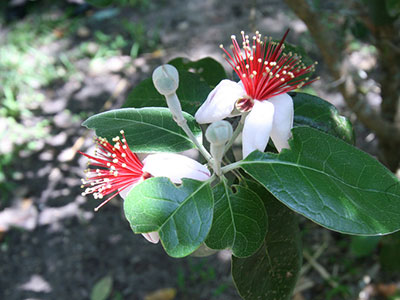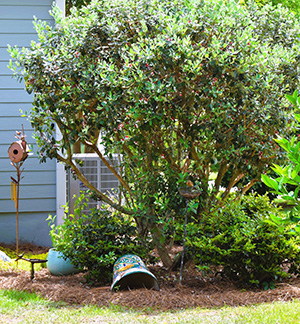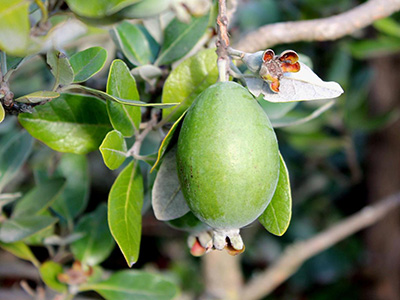Pineapple Guava
If gardening were an Olympic sport, pineapple guava might be a contender for best all-around shrub.

Pineapple guava is a favorite for its attractive silvery foliage, unusual flowers and edible fruits. This evergreen can be grown throughout Florida and is relatively easy to find in your local retail nursery.
Characteristics
Pineapple guava (Acca sellowiana), also known as feijoa, is native to South America, but also does well in tropical and subtropical climates throughout the world. It is especially suited for coastal gardens because it tolerates salt spray.
Pineapple guava can easily be pruned to form a dense hedge, shrub or trained into a small tree with a single trunk. At maturity, it can reach 10-15 feet tall and wide. For space efficiency or decorative appeal, try growing it as an espalier (trained to grow on a flat plane, often against a wall or trellis).
The evergreen, oval-shaped leaves are 2 to 3 inches long and have silvery, slightly fuzzy undersides that often give the entire plant a slight bluish cast.

The flowers appear from April through May and are 1 to 2 inches across. The fleshy petals are white or a soft pink and the stamens are a striking burgundy. An extra perk is that the flowers are edible; some compare the flavor to marshmallows. They can be added to salads, desserts and other dishes.
The egg-shaped fruits begin to mature and ripen in early fall. Some people liken the flavor to that of guava, while others say that it’s closer to a minty pineapple. Eat them fresh by cutting them in half and scooping out the pulp, or turn them into a delicious jelly.
Although pineapple guava is now known scientifically as Acca sellowiana, some older sources may still refer to it as Feijoa sellowiana.
Planting and Care
Pineapple guava can be grown in USDA Hardiness Zones 8-11, preferably in full sun or part shade. It thrives in a variety of soil types, but prefers slightly acidic soil. It does well with minimal pruning and care and typically won’t require much irrigation beyond normal rainfall. During extended droughts, however, it might drop fruit and leaves.
Gardeners who want to enjoy the pineapple guava fruit may wish to purchase one of the named self-fruiting cultivars like ‘Coolidge’ that have shown to perform well in Florida. Pineapple guava is best grown using known grafted cultivars. It can be grown from seed, but seedlings are slow growing and may not produce high-quality fruit.
Pineapple guava will begin producing fruit about 2-4 years after planting, and it reaches maturity and full fruiting potential at 8-10 years. Fruits can appear from September through November, depending on the variety. Once the first fruits of the season begin to fall, they are ready to harvest. Another indication of ripeness is the softening of the fruits and a transition to a lighter green.
Also note that fruit production may be low in extreme southern Florida, since the plants fruit better when they’re exposed to cold temperatures for 50 to 200 hours each winter. Extreme heat (above 100°F) may cause them to drop fruit prematurely. The fruit can also be damaged if temperatures drop below 28°F. It has no major pest or disease problems.
While pineapple guava is non-native, it is not invasive or a problem species in Florida per the UF/IFAS Assessment of Non-native Species.

This plant makes an excellent addition to any edible garden or coastal landscape, with its delectable fruits and flowers. For more information on pineapple guava, contact your county Extension office.

